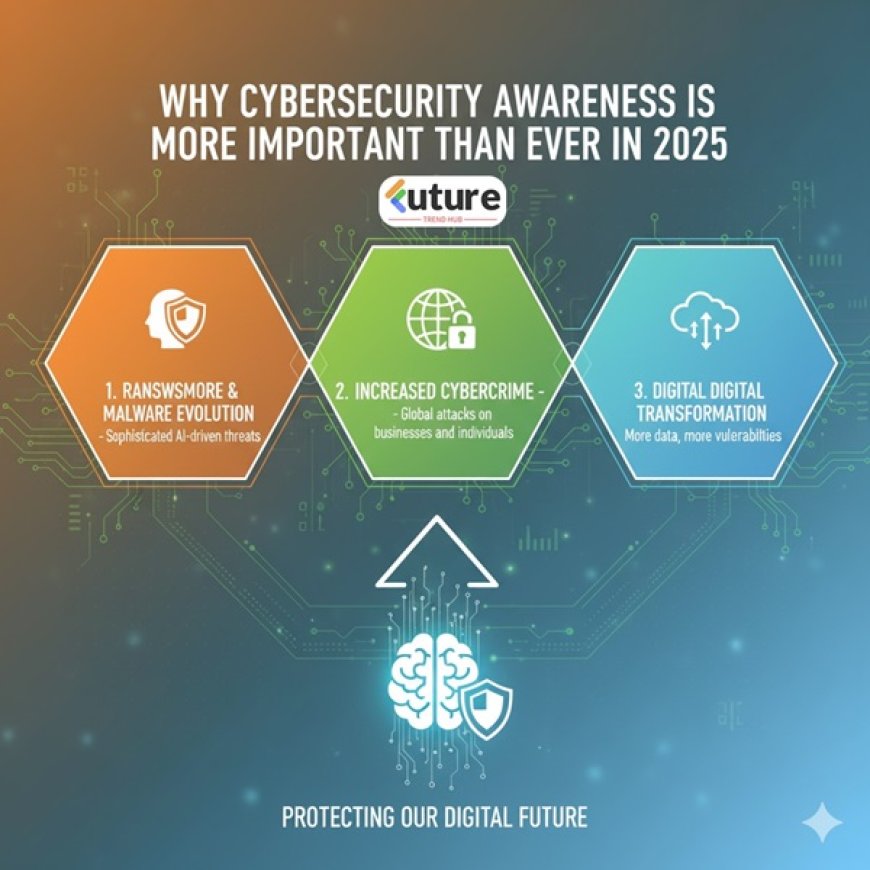Why Cybersecurity Awareness is More Important Than Ever in 2025
In today’s hyperconnected world, cybersecurity is no longer just a concern for IT departments—it affects everyone. From individuals using smartphones to multinational corporations managing vast amounts of data, the threat landscape is growing more complex. In 2025, cybersecurity awareness has become a top priority, as cybercriminals are adopting more advanced methods powered by artificial intelligence (AI), automation, and social engineering.

The Rising Cybersecurity Threat Landscape
Cyberattacks are evolving faster than ever. Some of the biggest risks in 2025 include:
-
AI-powered phishing scams that generate realistic, personalized emails.
-
Ransomware attacks targeting small businesses and critical infrastructure.
-
Deepfake technology used for identity theft and fraud.
-
IoT vulnerabilities, as more smart devices connect to home and business networks.
Without proper awareness, individuals and organizations remain highly vulnerable to these threats.
Why Cybersecurity Awareness Matters in 2025
1. Technology Adoption is Outpacing Security
The rapid adoption of cloud computing, 5G, and Internet of Things (IoT) devices has opened new attack surfaces. While technology makes life easier, many users underestimate the security risks. Awareness ensures people use these technologies safely.
2. Cybercriminals are Getting Smarter
Hackers now leverage machine learning to bypass security systems and launch sophisticated attacks. A lack of awareness can lead to human errors, such as clicking malicious links or reusing weak passwords, which remain the top entry points for attackers.
3. Businesses Face Increased Compliance Pressure
Governments worldwide are tightening cybersecurity regulations. Employees and leaders must stay aware of compliance requirements, data protection laws, and company policies to avoid legal and financial penalties.
4. Remote and Hybrid Work Expands the Risk
With many professionals working remotely, personal devices and home networks often lack enterprise-grade protection. Awareness training helps employees secure their digital environments, reducing organizational risk.
5. Awareness Builds a Strong Human Firewall
Even with advanced firewalls, AI-driven monitoring, and endpoint protection, people remain the weakest link. Cybersecurity awareness empowers individuals to recognize suspicious activity and respond proactively—building a strong human firewall.
How to Strengthen Cybersecurity Awareness in 2025
-
Regular Cybersecurity Training – Organizations should conduct ongoing awareness programs with real-world simulations.
-
Phishing Drills – Simulated phishing campaigns help employees identify red flags.
-
Strong Password Practices – Encourage unique, complex passwords and the use of password managers.
-
Promote Multi-Factor Authentication (MFA) – A critical defense against account takeovers.
-
Safe Remote Work Habits – Employees should use VPNs, encrypted communications, and secure devices.
-
Awareness Beyond the Workplace – Educating families and communities ensures security habits extend into daily digital life.
The Future of Cybersecurity Awareness
By 2025, cybersecurity is not only about technology but also about behavioral change. The future of awareness programs will be more interactive—using gamification, virtual reality training, and AI-driven simulations to engage users. The goal is to make cybersecurity second nature, just like locking your front door.
Final Thoughts
Cybersecurity awareness is the foundation of digital safety in 2025. As threats become more sophisticated, informed users and employees are the first line of defense. By prioritizing awareness, individuals protect their personal data, and businesses safeguard their reputation, compliance, and customer trust.
In short, technology alone can’t secure the future—people must be equally vigilant.







